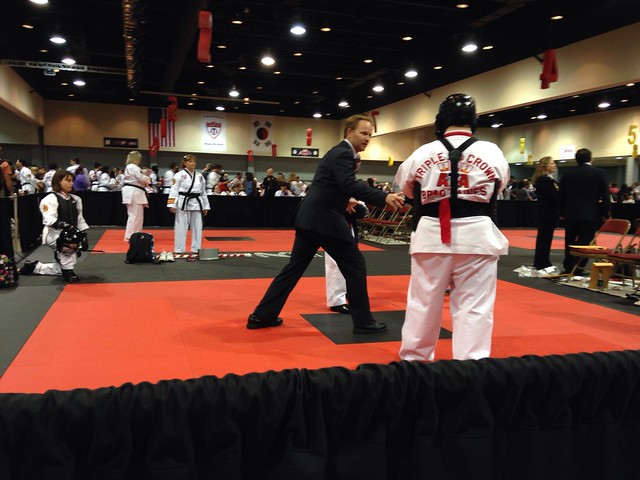Participating in the structure of a tae kwon do class has been a huge benefit to Caleb socially and physically since he began almost 4 years ago. His motor skills alone have improved tremendously, from balance, to strength, to general coordination. Not to mention the security of a structured class setting. In the beginning he would rarely acknowledge his classmates. I remember one week where he stood in the corner for an hour refusing to participate because he had a cut on his finger. Person after person, came to invite him in, and again and again he repeated, "I have a cut on my finger."
Persistence and patience on the part of Caleb and his instructors paid off, however, and with very few modifications, he earned his black belt in May of 2013.
Much of a surprise to all of us (he's not one for being in the spotlight), Caleb has always enjoyed participating in tournaments. He cherished each of his participant medals. As he advanced through the color belt ranks, however, it became increasingly apparent the gap between his abilities and that of his peers. His memory (which is very segmented between facts and motor skills) began to struggle as the forms became longer. His reaction times for sparring became dangerously slow as the other students increased their abilities. His focus could be all over the place.
 |
The ATA, our organizing body, provides for divisions for black belt juniors and adults with both cognitive and physical disabilities. Application is done through head quarters to ensure that athletes are place appropriately. It is not unusual to see competitors in wheel chairs, using walkers, with down's syndrome and other struggles. The rings are not particularly large, but they are full of enthusiasm! The judges, especially at national events, can often be seen helping a competitor with their gear or helping redirect an athlete with autism or down syndrome back to their spot when they have wandered away. These two gentlemen in the 30+ cognitive ring both have down's syndrome and their spirit and enthusiasm was a joy to watch. A huge refreshment from the hyper competitive *spirit* that sometimes shows up in other rings. Both gentlemen had their parents with them and I couldn't help notice the joy on their faces. This clearly meant a lot to them as well.

Special abilities rings provide not only a safe place for competitors of varying abilities, but including special abilities athletes in the organization provides role models for younger students. My friend Mary, from Salt Lake City, has MS. As a part of her disability she is unable to kick and modifies all of her forms for exclusively hand techniques. She also earned 3 (I think!) world titles this year and recently tested for her 2nd Degree Recommended Black Belt. She is always willing to practice with Caleb and was one of the loudest members of his cheering squad on Saturday.

In addition to special abilities rings, the ATA provides for the dignity of every athlete in many other ways. ATA has a partnership with Autism Speaks and has developed a training program for instructors to assist them in working with students on the Autism Spectrum, a training I was excited to attend at 2013 Spring Nationals. The training helps instructors understand the adaptations that may be necessary for students, while promoting the benefits of martial arts.
Athletes of all backgrounds are celebrated through the ATA. Watch this video to check out, now Master, Plaid's story. Not only have Master Plaid's physical accomplishments reached an impressive level, he is an incredible instructor. He loves to travel to many tournaments throughout the year and interact with the younger athletes. We do not see him sitting in the background, he is right in there judging and encouraging all of the students.
In the ATA, special abilities athletes are simply athletes in another ring. They train with the same instructors, compete for the same titles and prizes, and in the end earn the benefits of the sport and more. I am so grateful that by a happy accident we ended up a part of this incredible organization and landed in a school with such diversity on the part of the student body and openness on the part of the instructors.
Our head instructor once said to me, when I expressed my concerns about his class behavior, "Oh Caleb's fine. You know what I love about Caleb? He keeps me on track. Man if I forget to say turn and look before a move, he reminds me. If I say we are going to play a game with five minutes of class left and there are four minutes of class left, he reminds me. He always remembers what I say."
Some people might be inclined to exclude such an intrepid interrupter. Some people might be inclined not to award the next rank to a student who needs to stop so many times during his form, or move so slowly through it. Who might growl at the person who dares to help him, when he believes he can do it himself.
Not the ATA.
In the ATA, Caleb is so more than a kid with autism. He is an athlete.

2 comments:
I love this.
Wow! This is really neat to read about! Thanks Heidi!
Post a Comment